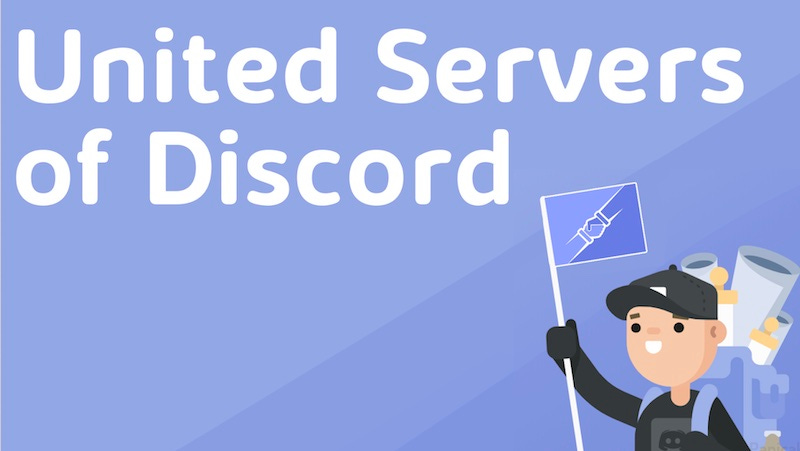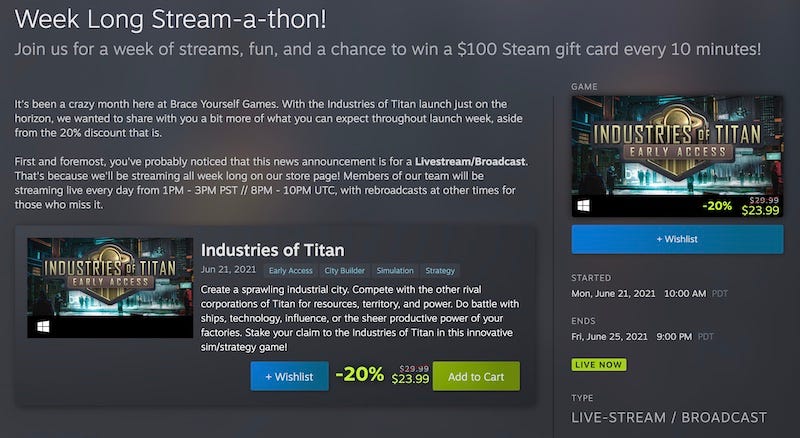
Featured Blog | This community-written post highlights the best of what the game industry has to offer. Read more like it on the Game Developer Blogs or learn how to Submit Your Own Blog Post
Game localization for discovery: it's trickier than you think! 2
So, it turns out localization is a really important part of game discovery, since it opens up so many new potential markets for your PC/console games. How does localization and discovery interact?

[The GameDiscoverCo game discovery newsletter is written by ‘how people find your game’ expert & GameDiscoverCo founder Simon Carless, and is a regular look at how people discover and buy video games in the 2020s.]
A non-sequitur to start today’s newsletter: I love about the premium PC/console game industry in 2021 is that any game can be a hit. I mean it. Check out Cruelty Squad on Steam - an immersive sim with a completely bizarre aesthetic, but gameplay depth galore. One of the recent Steam reviews says the player has “personally been mostly just collecting organs and… doing the stock market.” Uh, what?
Anyhow, this game just went 1.0, and Steam250 estimates its net revenue (using GameDiscoverCo-calibrated estimates) somewhere between $300k and $900k - and median sales of 60,000 units. And it’s only been out for 6 months. I love the market that creates hits like this, and you should too. So let’s get to looking at that darn market…
Localization & discovery - some angles to consider

So, it turns out localization is a really important part of game discovery, since it opens up so many new potential markets for your PC/console games. How does localization and discovery interact? Well, for example - the Chinese market is massive on Steam.
If your game isn’t translated into Chinese, most of the millions of Steam players in China won’t even see it as a default game in their Steam store. (Another way to look at it: if you do a Chinese translation, it’s like you’re competing in a different Steam store with 6,000 games instead of 34,000. Sounds like a good idea, right?)
Anyhow, above is a handy graph compiled by Nimdzi Research last year, crunching the numbers across all Steam games in 2019 and 2020 to see which languages are moving up or down. And it can be quite dynamic - Nimdzi noted that “the proportion of Russian (which outpaced Spanish) and Simplified Chinese (which outpaced Italian) [games] increased, and Korean pushed Polish out of the top 10.”
So whether you’re a tiny indie or a massive company, how should you think about localization with regard to discovery? Here’s some key points:
Try to get localization into your discovery story as early as possible: don’t just jam in localizations and tick the Steam page boxes at the last minute! Translate your Steam pages for launch, and even make translated versions of your Steam demos/Next Fest showcases for maximum reach. It can make a big difference.
Move away from those historic ‘EFIGS’ trends: it used to be that you would translate your game into EFIGS - English, French, Italian, German, and Spanish - and then be done. But the added reach - on PC in particular - of adding other languages (particularly Chinese!) has become incredibly important in recent years. Don’t start with EFIGS.
Think carefully about cost/benefit for text heavy games: if you’re using professional translation for games with tens of thousands of words of text, your costs might get into six figures (USD!) if you do a lot of translations. So you do need to think: how many more copies am I selling with this extra language, and am I taking into account ‘gross to net’ when working out the upside?
Consider using crowdsourced translations - but beware pitfalls: you can read this ‘how to’ from Krumit’s Tale on crowdsourced translations, in this case using Localizor. And if you’re running with a low budget or want some very exotic languages supported, it’s worth considering it. But you ‘get what you pay for.’ A smaller game may not get any translation interest at all. And when you do get helpers, sometimes the translations are Google Translate quality, sometimes they’re OK. And it’s difficult to work out which, until you show the public…

Finishing off this section with some comments from practitioners: Chris Wright, head of wondrous narrative publishing label Fellow Traveller, said his company prioritizes localizing to languages “that open up markets of size that we might not otherwise have done well in or been able to launch in”.
Of course, he does also have French and German language versions of his games (like Genesis Noir, shown above in Simplified Chinese). But the top ‘bang for the buck’ for languages, in his view, are as follows:
Simplified Chinese
Japanese, if it's also on Switch (opens up the Japanese market.)
Traditional Chinese, if it's also on Switch (opens up the Taiwan/Hong Kong store.)
Russian
Brazilian Portuguese
Chris particularly noted that Chinese localization (and local PR help) took some of his catalog from 5% or less of units in China sold to 20% or more. (Though obviously there’s a cheaper USD-equivalent price and more Steam refunding in China.)
Also weighing in on this when it was discussed in the GameDiscoverCo Plus Discord (we got permission to reprint their comments, btw) was Tim Bender of strategy publisher Hooded Horse. He has been analyzing Steam wishlist rates, comparing a) rates prior to the announcement of localization, and b) rates after the announcement of localization and a localized Steam page was uploaded.
He notes, across a couple of games in his catalogue: “For languages like French and German, my estimates are that 60-65% of ‘post announcement’ wishlists in that country would have occurred anyway. So 35-40% of the ‘post announcement’ wishlists were because of the localization. Theerefore, localization caused around a 50% country-specific increase in wishlists.
Elsewhere, looking at Spanish, slightly over half of wishlists were because of the localization. So that’s a little over 100% increase in wishlists. And for East Asian languages, over 90% were because of the localization.”
So that’s further indication that things aren’t as simple as ‘where does a platform have the most users? Localize there!’ It’s also about maximizing discovery in those areas of the world where there’s less English speakers - your post-localization sales increase may be larger. Which is why localization choices are trickier than you think…
Discord: server alliances for the win?

Recently, I’ve been talking with Stephen ‘MrGameTheory’ Takowsky over at 505 Games, who compiles the ‘top Discord server’ charts we’ve discussed a couple of times. But he also has an interesting new project - the United Servers Of Discord ‘club’ for some of the top video game-related Discords. (Here’s a presentation introducing it.)
As Stephen explains: “The Alliance creates joint events that promotes communities in other communities 3+ times per day. This is a massive cross pollination effort among some of the largest communities on Discord. The largest Roblox, League of Legends, and Animal Crossing communities are involved. There are official communities like Terraria, Spellbreak, Nookazon, and Dying Light who have joined with their official community teams.”
Couple of takeaways, here - firstly, if you have a Discord with at least 10,000 members, you can potentially join up with the Alliance to discuss best practices in a shared private Discord server, and also do joint events on your own servers. (And if you have at least 100,000 members, you can participate in their events without being an Alliance member.)
As for these cross-server events, there have been trivia contests using Discord bots, a cross-server chat, and on Saturday June 19th, Stephen noted that “we began our next big alliance event, a Summer-themed art event. Members of all participating servers can submit and vote on the winners. This is a great way for communities to create UGC and display their brands and talented artists within other communities.”
Even if you’re not large enough to join up with these bigger Discord cross-server advances, which include leaderboards, stats, and seasons between Alliance servers, it’s really good ‘food for thought’ as to clever, interactive ways to make your game’s Discord come alive. (One of the Discords I’m in just added the Groovy bot in a channel for shared Spotify playlists, for example!)
Finally, Stephen is also getting even further into Discord experimentation and self-government (!) with the Discord server for the town-building action RPG Eiyuden Chronicle, as he explains:
“We are calling it the Eiyuden Chronicle Republic, and its governing body is the tens of thousands of Kickstarter backers of the project. They have access to private channels on Discord where they can suggest, discuss, and vote on community policies [focusing on] community events, prizes, flags, apparel, and membership pins. Guess you can call all of this the ‘Rise of Game Community Governments’?” That should be.. interesting, to say the least!
The game discovery news round-up..

There was an unfortunate incident with an underground water pipe (and subsequent late-night construction noise!) near GameDiscoverCo HQ. This means we’re not exactly running on all cylinders today.
But luckily, we’d already banked a lot of interesting game discovery links in our bottomless sack of information. So we just have to lay them out for you, our work is done, and a nap awaits! Let’s do it:
Interesting to see Microsoft hiring the very smart Kim Swift (Portal) to “build a team focused on new experiences in the cloud”, with a focus on making cloud-native games for Xbox. I joked on Twitter: “Cloud-native games still the Moby Dick of cloud gaming aspirations - much chased, but just beyond the horizon.” Tricky to make an experience that 100% requires cloud and is technically suited for it.
Following up our newsletter on Argentina & Steam sales from last week, SteamDB says that “Valve added a limit on how often you can change your Steam account's country. Country may not be updated more than once every 3 months. Purchases can be completed using a payment method from your current region.” We also got some complaints from Argentinian Steam players who thought we were criticizing their country (we weren’t) and pointed out high local taxes, FWIW.
Over at Twitter, they’ve been recapping the most popular games (and eSports) mentioned on the service in the first half of 2021. Not convinced that RTs always equal sales. But on the high end, bulk mentions matter. And worldwide, Genshin Impact, Apex Legends, and the lesser-known mobile idol trading game Ensemble Stars were the top 3 most-mentioned. More data that way, including top E3 games (the Legend Of Zelda sequel beat out Elden Ring for Twitter hype!)
There’s been little data on PlayStation Now’s most popular games. So it’s good to see Sony recapping the download/cloud service’s top games for March, April, and May 2021 by play time. Marvel’s Avengers - which has a limited PSNow engagement until July 5th - topped PS4/PS5 play, but Bloodborne was the game most commonly streamed to PCs. Look forward to more info here soon.
Hotly discussed in the GameDiscoverCo Plus Discord this week was the Steam launch of Brace Yourself Games’ futuristic strategy/citybuilder Industries Of Titan, which came with an interesting promotion: “we'll be giving away a $100 Steam gift card every 10 minutes [for launch week]. Non-stop. All you have to do is type '!contest' into the Steam chat.” That’s $91k in Steam gift cards, wow. (We have some questions in to Ryan Clark at Brace Yourself about this strategy.)
Microlinks: interesting to see Humble do its first bundle with Epic Games Store theming & keys; could touchscreen tabletop game PCs like the Infinity Game Table (from the Arcade1Up crew) be a new trending thing?; there’s some new free online cross-platform services from Epic, including Easy Anti-Cheat and Voice modules.
Finally, some of you may know I’m a board member for the Video Game History Foundation, Frank Cifaldi and Kelsey Lewin’s excellent non-profit which is doing a lot of video game history & culture saving. (Recent examples: excavating Earthbound’s ‘lost’ localization text, resurrecting a previously unseen ‘90s Midway baseball game.)
Anyhow, I was prepping social media for the VGHF Twitter account and thinking about how game discovery was done 20-30 years ago. With the visual Internet not really up and running, a lot of it was… print advertisements. And as I said on Twitter: “it can’t be understated how deeply stupid ‘90s video game print ads were”:

This ad is for PF Magic and Accolade’s Ballz, by the way, a 3D fighting game that exclusively used spheres for character rendering (!) You might know PF Magic better for making the Catz and Dogz series of virtual pet sims. Fascinating stuff.
[We’re GameDiscoverCo, a new agency based around one simple issue: how do players find, buy and enjoy your premium PC or console game? You can subscribe to GameDiscoverCo Plus to get access to exclusive newsletters, interactive daily rankings of every unreleased Steam game, and lots more besides.]
Read more about:
Featured BlogsAbout the Author(s)
You May Also Like







.jpeg?width=700&auto=webp&quality=80&disable=upscale)








